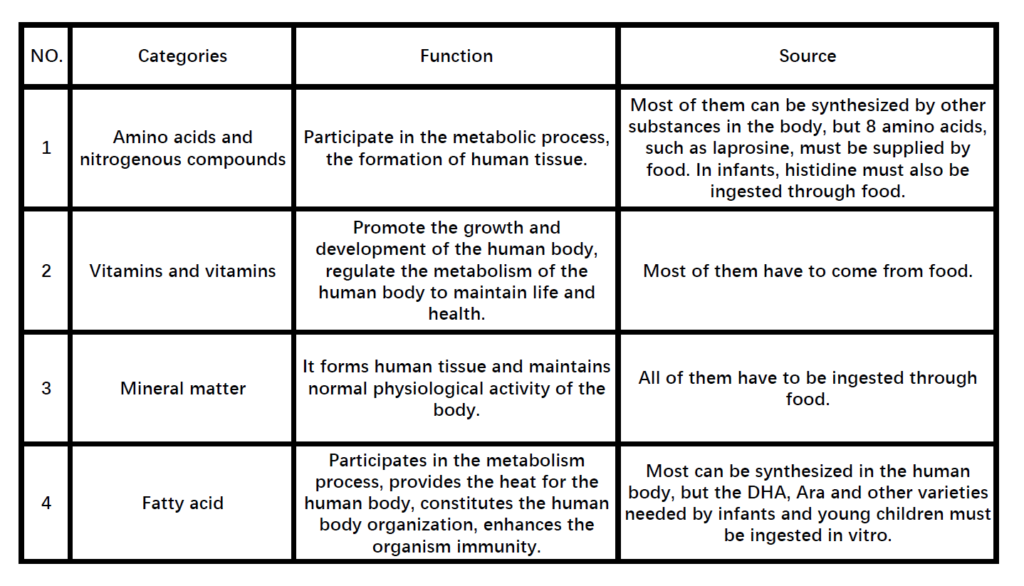1. The concept and classification of food nutrition fortifiers
Food nutritional fortifiers refer to natural or synthetic food additives that are added to foods to increase nutritional components and belong to the scope of natural nutrients. Food nutritional fortifiers are an important class of food additives used to supplement some nutrients in the human body. It is mainly divided into four categories: amino acids and nitrogen-containing compounds, vitamins and vitamins, minerals, and fatty acids. The specific classifications are as follows:

Food nutritional fortifiers have a very important impact on the modern food industry. The rational use of food nutrition fortifiers can effectively improve the nutritional function of food and greatly increase the market value of food. However, improper use of food nutrition fortifiers may lead to waste of food nutrients, and even have adverse effects on the human body. Due to the above-mentioned effects of food nutritional fortifiers, countries have strictly regulated the production and use of food nutritional fortifiers.
China has formulated special regulations such as “Classification and Code of Food Additives” and “Hygienic Standards for the Use of Food Nutrition Fortifiers”, which strictly regulate the types and scope of use of food nutrition fortifiers. In addition, China has also formulated special laws and regulations such as the “Food Safety Law” and “Food Additive Hygiene Management Measures”, which strictly regulate the production and circulation of food nutrition fortifiers.
Food nutrition fortifiers have the characteristics of large overall scale, many varieties, and high production conditions. There are more than 25,000 varieties of food additives in the world, and more than 5,000 commonly used varieties. The United States is one of the countries with the largest amount and variety of food additives in the world. The US FDA recently announced a list of 2,922 food additives, of which 1,755 are regulated. There are 1967 listed in the U.S. Food Chemicals Codex. About 1,100 kinds of food additives are used in Japan. There are 1,000-1,500 species allowed in the EU. There are about 2,400 kinds of food additives allowed in China.
With the development of Chinese society and the improvement of per capita disposable income, the concept of social diet has changed from the food and clothing type to the nutrition and health type. In order to meet the needs of various groups of people for nutrients, more and more foods are added with nutritional fortifiers. And the subsequent development of nutritional fortifier manufacturers will continue to carry out technological innovation. At the same time, the food and health supervision departments will continue to improve, update and formulate relevant standards and testing methods to promote the development of the nutritional fortifier industry in a healthy direction.
2. Industry authorities, regulatory system, major laws and regulations and industry standards
According to the “Food Safety Law”, “Food Safety Law Implementation Regulations” and other laws and regulations, the Ministry of Health of China takes the lead in establishing a comprehensive food safety coordination mechanism, is responsible for comprehensive food safety supervision, and organizes the investigation and punishment of major food safety accidents. The Ministry of Agriculture is responsible for the supervision of agricultural production. The General Administration of Quality Supervision, Inspection, and Quarantine of the People’s Republic of China is responsible for the supervision of food production and processing and the safety of imported and exported food. The State Administration for Industry and Commerce is responsible for the supervision of food circulation. The State Food and Drug Administration is responsible for food safety supervision in the catering industry, canteens, and other consumption links.
The main regulatory laws and regulations and industry standards in the industry mainly include: “Food Safety Law of the People’s Republic of China”, “Implementation Regulations of the Food Safety Law of the People’s Republic of China”, “Regulations on the Supervision and Administration of Food Additive Production”, “Food Additive Hygiene Management Measures”, ” New Resource Food Management Measures, Hygienic Standards for Food Additive Manufacturing Enterprises, Regulations on the Declaration and Acceptance of Food Additives of the Ministry of Health, Measures for the Administration of Food Hygiene Licenses, Hygienic Standards for the Use of Food Additives (GB 2760-2007), “Hygienic Standards for the Use of Food Nutrition Fortifiers” (GB 14880-2012), “Measures for the Hygienic Administration of Food Nutrition Fortifiers”, and “Classification and

3. Industry development prospects and trends
According to statistics, the output value of food additives in China accounts for about 1% of the total output value of the food industry. This ratio is lower than that of countries and regions with developed food industries such as Europe and the United States. In traditional foods such as dairy products, flour, meat products, fruit and vegetable products, etc., there are still problems in the use of food additives in a low amount or improper use of food additives, resulting in different food products, short storage time, unbalanced nutritional value, and unbalanced nutritional value. Conducive to increasing the added value of products.
The pace of life in modern society is accelerating, and the time and energy that the public spends on meal preparation are decreasing, making it more and more difficult to obtain all the nutrients required for metabolism through meal matching. Various types of nutrient deficiencies occur from time to time, affecting the physical and mental health of the public to varying degrees. In this context, the need to ingest certain types of nutrients by oral means arises. The easiest way to achieve this goal is to use various food nutritional supplements and daily meals to make various functional foods and beverages. With the continuous progress in the research of functional foods and beverages, the variety and competition pattern of food additives in China will undergo great changes. With the growth of the food industry, the market capacity of new food additives, especially food nutrition fortifiers, will increase significantly.
4. Industry competition pattern
There are many varieties of food nutrition fortifiers, and the market structure of different varieties is quite different. The manufacturers of some varieties are multinational chemical companies with strong comprehensive strength, including BASF (BASF), DSM (DSM), Adisseo (Adisseo), Martek (Martek), and other companies. In recent years, due to the breakthrough of production technology, cost, and other factors, food additives have gradually shown a trend of transferring to developing countries, especially Asia. European and American manufacturers have begun to gradually give up the production of some products and turn to purchase from manufacturers in developing countries to produce downstream products. The Chinese industry is facing development opportunities.
At present, China has the core technology to produce a variety of food nutrition fortifiers and has become one of the world’s major producers of food nutrition fortifiers. There are a large number of production enterprises in the industry, but for some technology- and capital-intensive products with excellent functions, there are few enterprises that can produce them, and the production has a certain scale effect, and the industry has certain barriers to entry. The global market is usually composed of several Not many advantages companies share. Some domestic production enterprises already have certain international competitiveness and have a relatively high market position in certain products.
At present, China’s food industry is in a period of rapid growth, with an annual growth rate of 12%, and the growth rate of food additives is 12-14%. As an important part of food additives, nutritional fortifiers can supplement specific nutrients in the human body and promote human health, and their potential market demand is huge. VA, VB1, VB2, folic acid, niacin, iron, iodine, zinc, and calcium have been identified as the main varieties of nutritional fortifiers in my country in the overall concept of food fortification of the Chinese National Public Nutrition Project Group. The state has also promoted nutritionally fortified flour since 2000 and has issued a national standard for nutritionally fortified flour, “Nutrition-fortified Wheat Flour”, which fully demonstrates the state’s support for nutritionally fortified foods.

The consumption of food nutritional supplements is closely related to the local economic growth rate. In 2002, the survey on the use of nutritional fortifiers in adult food in China showed that the utilization rate of nutritional fortifiers in adult food in China was 5.1%. In comparison, 52% of Americans over the age of 20 use food nutritional supplements, which is significantly higher than that of Chinese residents. As a developing country in China, nutritional deficiencies, especially micronutrient deficiencies, are still one of the main causes of harm to public health. Under the premise of promoting balanced nutrition and a reasonable diet, the rational use of food nutritional supplements can improve nutritional deficiencies, prevent the occurrence of chronic diseases and promote health. At the same time, the popularization of nutrition knowledge is carried out in a targeted manner, so that people can rationally use food nutrition fortifiers. With the sustained and rapid development of the domestic economy and people’s increasing awareness of health care, China’s demand for food nutrition fortifiers has become a new bright spot in the growth of the food nutrition fortifier market.
In addition, food nutrition fortifier is an important component of healthy food. The rapid development of health food and other industries has brought stable market demand for the food nutrition fortifier industry, which is conducive to the sustainable development of the food nutrition fortifier industry.
5. The degree of marketization
After years of development, China’s food nutrition fortifiers have become a highly market-oriented industry. There is no government intervention in the industry in terms of product prices and product production plans. Product prices are completely determined by market supply and demand.
Food additives have become the fourth type of fine chemical industry that has attracted much attention after pharmaceuticals, agricultural chemicals, and feed additives. The annual growth rate is expected to be 2%-3% in the next 5 years. Food additives with the strongest demand growth will be nutritional fortifiers such as vitamins and minerals, flavor enhancers, and fat substitutes.
The development trend of food in the 21st century is natural, nutritious, healthy, safe, and hygienic. Food additives closely related to food must be based on this criterion. With the rise of the modern food industry and the improvement of people’s living standards, consumers’ health awareness has increased. Nutritious food, health food, functional food, green food, etc. have become hot spots in the food consumption market. The status of food additives is increasingly prominent. The concept of pursuing low-fat, low-calorie food has made “double low” food popular in the world, prompting food processing and manufacturing enterprises to continuously use new raw materials in food formulations, and driving the development of the food additive market. At the same time, the holding of a series of international food additive exhibitions has also promoted the rapid growth of the food additive industry. Advocating nature and returning to nature has become an irresistible trend in the world. In the minds of many consumers, the view that “natural is safe” and “natural is at least safer than synthetic” has been deeply rooted. Natural and healthy have become the leading direction of the development of food additives today. Food additives with the strongest demand growth will be nutritional fortifiers such as vitamins and minerals, as well as flavor enhancers and green and natural preservatives.
At present, the largest category of products in the global food additives market is flavoring agents, followed by acidulants, while nutritional fortifiers and fat substitutes are the fastest-growing products in recent years. China’s food additive industry started late, but the industry has developed very rapidly, and it has become one of the most active and fastest-growing industries in the food industry.

